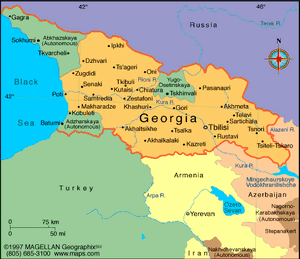Pitsunda
| Author: Laxman Burdak, IFS (R) |

Pitsunda is a resort town in the Gagra District of Abkhazia/Georgia. Its ancient name was Pityus.
Variants
- Pitsunda
- Abkhazian: Пиҵунда,
- Russian: Пицунда
- Pityus (Ancient Greek: Pityus, Πιτυοῦς, genitive Pityuntos, Πιτυοῦντος)
- Bichvinta (Georgian: ბიჭვინთა [bitʃʼvintʰɑ])
- Pezonda
Jat Gotras Namesake
- Pat + Sunda = Pitsunda = Pityus (Pliny.vi.5)
Location
The political status of Abkhazia is disputed. Having unilaterally declared independence from Georgia in 1992, Abkhazia is formally recognised as an independent state by 5 UN member states (two other states recognised it but then withdrew their recognition), while Georgia continues to claim it as part of its own territory, designating it as Russian-occupied territory.
History
Founded by Greek colonists in the 5th century BC, Pitsunda became an important political and religious centre of the region in the antiquity and the Middle Ages.
Pityus was a large and wealthy Greek city in the antiquity.[1] Pliny wrote in AD 77 that the city had been sacked by the Heniochi.[2][3] A Roman fort was founded at Pityus in the first half of the 2nd century and a detachment of Legio XV Apollinaris was stationed there.[4] The city was surrounded by a defensive wall, the castellum had a second line of defence built in mid-3rd century AD.[5] Excavations guided by Andria Apakidze unearthed, in 1952, remains of three 4th-century churches and a bath with high-quality mosaic floors. The former "Great Pityus" harbour is now a mere lake within the town.
The Goths (Called Scythae and Borani in contemporary sources) attacked the city in 255 AD after capturing the Bosporan fleet. The Roman garrison under the command of Successianus repelled the attack, however they returned in the next year, took the city and proceeded further to sack Trebizond.[6]
Saint John Chrysostom was being led towards Pityus by the imperial soldiers, in execution of the decree of exile, when he died on the way in 407.[7] Like Dioskurias (modern Sukhumi), it remained under Roman control within the Georgian kingdom of Colchis until the 7th century. The city passed under Abasgian control and became one of the major political and religious centres of the kingdom of Egrisi (Lazica). An archbishopric of Pitiunt was instituted in 541. In medieval Georgia, the town's name was spelled as Bichvinta. At the end of the 10th century, King Bagrat III of Georgia built there the Pitsunda Cathedral which survives to this day and contains vestiges of wall-painting from the 13th and the 16th centuries. Bichvinta also served as the seat of the Georgian Orthodox Catholicate of Abkhazia until the late 16th century when Abkhazia came under the Ottoman hegemony. In his 1911 article for the Catholic Encyclopedia, Sophrone Pétridès described Pityus as a titular see,[8] but it is not now found in the Catholic Church's list of such sees.[9] In the late 13th century, the area housed a short-lived Genoese trade colony called Pezonda.
Pitsunda was the favourite resort of First Secretary of the Communist Party of the Soviet Union Nikita Khrushchev. In October 1964 he happened to be vacationing in Pitsunda when he was deposed from power. Khrushchev once proposed a major dam and hydroelectric power scheme on the Bzyb River near Pitsunda, but his experts informed him that a dam built on the Bzyb River would have had catastrophic effects in causing beach erosion at Pitsunda. In the end, the dam was built on the Inguri River instead, where the impact upon the coastline was assessed to be considerably less pronounced.[10]
Mention by Pliny
Pliny[11] mentions....In the innermost part11 of this district there was Pityus12, a city of very considerable opulence, but destroyed by the Heniochi: behind it are the Epageritæ, a people of Sarmatian origin, dwelling upon the range of the Caucasus, and beyond them, the Sauromatæ.
11 Meaning, nearly in the extreme corner of Pontus.
12 In the time of Strabo this was a considerable sea-port, and after its destruction by the Heniochi, it was restored, and served as an important frontier fortress of the Roman empire against the Scythians.
References
- ↑ Herbermann, Charles, ed. (1913). "Pityus" . Catholic Encyclopedia. New York: Robert Appleton Company.
- ↑ Herbermann, Charles, ed. (1913). "Pityus" . Catholic Encyclopedia. New York: Robert Appleton Company.
- ↑ David, Braund (1994). Georgia in Antiquity. A History of Colchis and Transcaucasian Iberia 550 BC AD 562. Calendon Press. p. 176. ISBN 0198144733.
- ↑ David, Braund (1994). Georgia in Antiquity. A History of Colchis and Transcaucasian Iberia 550 BC AD 562. Calendon Press. p. 176. ISBN 0198144733.
- ↑ Kacharava, D. D. (1983–1984). "Archaeological Investigations on the Eastern Black Sea Littoral, 1970-80". Archaeological Reports. The Society for the Promotion of Hellenic Studies. 30 (30): 99. doi:10.2307/581033. JSTOR 581033. S2CID 128624772.
- ↑ Wolfram, Herwig; Dunlap, Thomas J. (1990). History of the Goths. University of California Press. p. 49. ISBN 978-0-520-06983-1.
- ↑ Herbermann, Charles, ed. (1913). "Pityus" . Catholic Encyclopedia. New York: Robert Appleton Company.
- ↑ Herbermann, Charles, ed. (1913). "Pityus" . Catholic Encyclopedia. New York: Robert Appleton Company.
- ↑ Annuario Pontificio 2013 (Libreria Editrice Vaticana, 2013, ISBN 978-88-209-9070-1), p. 953
- ↑ Blatter, Joachim; Ingram, Helen M. (2001). Reflections on water: new approaches to transboundary conflicts and cooperation. MIT Press. pp. 221–2. ISBN 0-262-02487-X.
- ↑ Natural History by Pliny Book VI/Chapter 5

